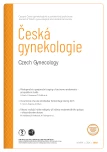New recommendations for informing patients and gamete donors in assisted reproduction
Authors:
H. Konečná
; Z. Elišková
; I. Honzová
Authors‘ workplace:
Zdravotně sociální fakulta, Jihočeská univerzita v Českých Budějovicích
Published in:
Ceska Gynekol 2024; 89(1): 66-71
Category:
doi:
https://doi.org/10.48095/cccg202466
Overview
The number of cycles of assisted reproduction using donor body parts is increasing significantly. In Europe alone, around one hundred thousand children are born each year who have some relationship to three or more parents. The European expert guarantor European Society of Human Reproduction and Embryology therefore issued a recommendation in 2022 to inform donors, recipients and children born in this way. Our article analyses developments in this area and proposes a solution for the Czech Republic. It is necessary for providers to immediately respond to the fact that the anonymity of donation can no longer be guaranteed, and to adapt the content of consultations and informed consents of potential donors and applicants accordingly. Legislation then has two possible solutions: first to adopt a system of “polyparenthoods” or second to fundamentally limit donation cycles.
Keywords:
informed consent – assisted reproduction – family – counselling – gamete donation – children’s rights
Sources
1. Calhaz-Jorge C, De Greyter Ch, Kupka MS at al. Survey on ART and IUI: legislation, regulation, funding and registries in European countries: the European IVF-monitoring Consortium (EIM) for the European Society of Human Reproduction and Embryology (ESHRE). Hum Reprod Open 2020; 2020 (1): hoz044. doi: 10.1093/hropen/hoz044.
2. Human Fertilisation and Embryology Authority. Fertility treatment 2021: preliminary trends and figures. 2023 [online]. Available from: https: //www.hfea.gov.uk/about-us/publications/research-and-data/fertility-treatment-2021-preliminary-trends-and-figures/.
3. ÚZIS ČR, NRAR 2022. Asistovaná reprodukce v České republice. 2020 [online]. Dostupné z: https: //www.uzis.cz/res/f/008420/asistreprodukce2020.pdf.
4. Wyns C, Bergh C, Calhaz-Jorge C et al. The European IVF-monitoring Consortium (EIM) for the European Society of Human Reproduction and Embryology (ESHRE) and others. ART in Europe, 2016: results generated from European registries by ESHRE. Hum Rep Open; 2020 (3): hoaa032. doi: 10.1093/hropen/hoa a032.
5. Sdělení č. 96/2001 Sb., Sdělení Ministerstva zahraničních věcí o přijetí Úmluvy na ochranu lidských práv a důstojnosti lidské bytosti v souvislosti s aplikací biologiea medicíny: Úmluva o lidských právech a biomedicíně. 2001 [online]. Dostupné z: https: //www.zakonyprolidi.cz/ms/2001-96.
6. Zákon č. 373/2011 Sb., zákon o specifických zdravotních službách. 2011 [online]. Dostupné z: https: //www.zakonyprolidi.cz/cs/2011-373.
7. Zákon č. 89/2012 Sb., Občanský zákoník. 2012 [online]. Dostupné z: https: //www.zakonyprolidi.cz/cs/2012-89.
8. Sdělení č. 104/1991 Sb., Sdělení federálního ministerstva zahraničních věcí o sjednání Úmluvy o právech dítěte. 1991 [online]. Dostupné z: https: //www.zakonyprolidi.cz/cs/1991 - 104.
9. Pennings G, de Wert G, Shenfield F et al. ESHRE Task Force on Ethics and Law 13: the welfare of the child in medically assisted reproduction. Hum Reprod 2007; 22 (10): 2585–2588. doi: 10.1093/humrep/dem237.
10. Zegers-Hochschild F, Adamson GD, Dyer S et al. The international glossary on infertility and fertility care. Fertil Steril 2017; 108 (3): 393–406. doi: 10.1016/j.fertnstert.2017.06.005.
11. Frith L. Gamete donation and anonymity: the ethical and legal debate. Hum Reprod 2001; 16 (5): 818–824. doi: 10.1093/humrep/16.5. 818.
12. Ravitsky V, Guichon J, Lemoine ME et al. The conceptual foundation of the right to know one’s genetic origins. 2017 [online]. Available from: https: //www.progress.org.uk/the-conceptual-foundation-of-the-right-to-know-ones-genetic-origins/.
13. Crawshaw M, Adams D, Allan S et al. Disclosure and donor-conceived children. Hum Reprod 2017; 32 (7): 1535–1536. doi: 10.1093/humrep/dex107.
14. Golombok S. Disclosure and donor-conceived children. Hum Reprod 2017; 32 (7): 1532–1536. doi: 10.1093/humrep/dex104.
15. Ravelingien A, Pennings G. The right to know your genetic parents: from open-identity gamete donation to routine paternity testing. Am J Bioeth 2013; 13 (5): 33–41. doi: 10.1080/15265161.2013.776128.
16. Pennings G. Donor children do not benefit from being told about their conception. 2017 [online]. Available from: https: //www.progress.org.uk/donor-children-do-not-benefit--from-being-told-about-their-conception/.
17. Konečná H. Anonymita dárcovství gamet. Gyn Por 2019; 3 (4): 239–243.
18. CoE Recommendation 2156. Anonymous donation of sperm and oocytes: balancing the rights of parents, donors and children. 2019 [online]. Available from: http: //assembly.coe.int/nw/xml/XRef/Xref-XML2HTML-en.asp?fileid=27680&lang=en.
19. Binet JR, CDCJ CoE. Comparative study on access of persons conceived by gamete donation to information on their origins. 2022 [online]. Available from: https: //rm.coe.int/cdcj-2021-20e-final-publication-format-17122022/1680a97 134.
20. ESHRE Working Group on Reproductive Donation and others. Good practice recommendations for information provision for those involved in reproductive donation. Hum Reprod Open 2022; 2022 (1): hoac001. doi: 10.1093/hropen/hoac001.
21. Harper JC, Kennett D, Reisel D. The end of donor anonymity: how genetic testing is likely to drive anonymous gamete donation out of business Hum Reprod 2016; 31 (6): 1135–1140. doi: 10.1093/humrep/dew065.
22. Collins Y. Donor conception and direct-to-consumer DNA testing. 2019 [online]. Available from: https: //www.progress.org.uk/donor-conception-and-direct-to-consumer-dna - testing/.
23. Jirková K. Realizace kontaktů dítěte v pěs-tounské péče s rodiči a osobami příbuznými a blízkými. Praha, MPSV. Č.j. MPSV-2021/110589--233. 2021 [online]. Dostupné z: https: //www.mpsv.cz/documents/20142/225508/Metodika_ Realizace+kontakt%C5%AF+d%C3%Adt%C4% 9Bte+v+PP+s+rodi%C4%8Di+a+osobami+p% C5%99%C3%Adbuizn%C3%Bdmi+a+bl%C3% Adzk%C3%Bdmi.pdf/ca9b0aea-78ef-f354-bf 65-febc3a2d48c9.
24. Nařízení Rady (ES) č. 2201/2003 ze dne 27. listopadu 2003 o příslušnosti a uznávání a výkonu rozhodnutí ve věcech manželských a ve věcech rodičovské zodpovědnosti a o zrušení nařízení (ES) č. 1347/2000. 2003 [online]. Dostupné z: https: //eur-lex.europa.eu/legal-content/CS/TXT/PDF/?uri=CELEX: 32003R2 201.
25. Návrh Nařízení EP a Rady o standardech jakosti a bezpečnosti látek lidského původu určených k použití u člověka a o zrušení směrnic 2002/98/ ES a 2004/23/ES. 2022 [online]. Dostupné z: https: //eur-lex.europa.eu/legal-content/CS/TXT/ PDF/?uri=CELEX: 52022PC0338&from=CS.
26. TAČR výstup „Psychosociální a etické principy pro legislativu ke krvi, tkáním a buňkám“. 2023 [online]. Dostupné z: https: //www.zsf.jcu.cz/images/ZSF/veda-a-vyzkum/projekty/VystupyTL05000144_darcovstviCastiTelaCR/primcipy-pro-btc-legislativu-navrh-2023-duben4.pdf.
27. Pennings G, The forgotten group of donor-conceived persons. Hum Reprod Open 2022; 2022 (3): hoac028. doi: 10.1093/hropen/hoac 028.
Labels
Paediatric gynaecology Gynaecology and obstetrics Reproduction medicineArticle was published in
Czech Gynaecology

2024 Issue 1
Most read in this issue
- Ultrasound finding of endometrial polyp and factors increasing risk of malignancy
- Diagnostika a léčba endometriózy
- Importance of vaginal packing after laparoscopic sacrocolpopexy – retrospective study
- Female orgasm, reproduction and couple relationships
